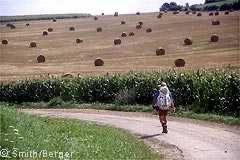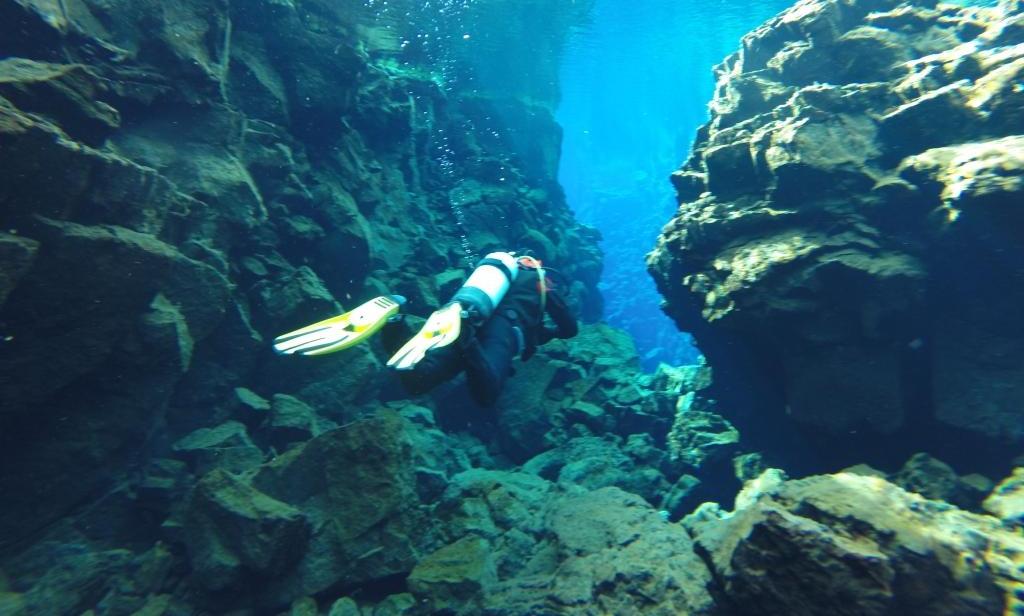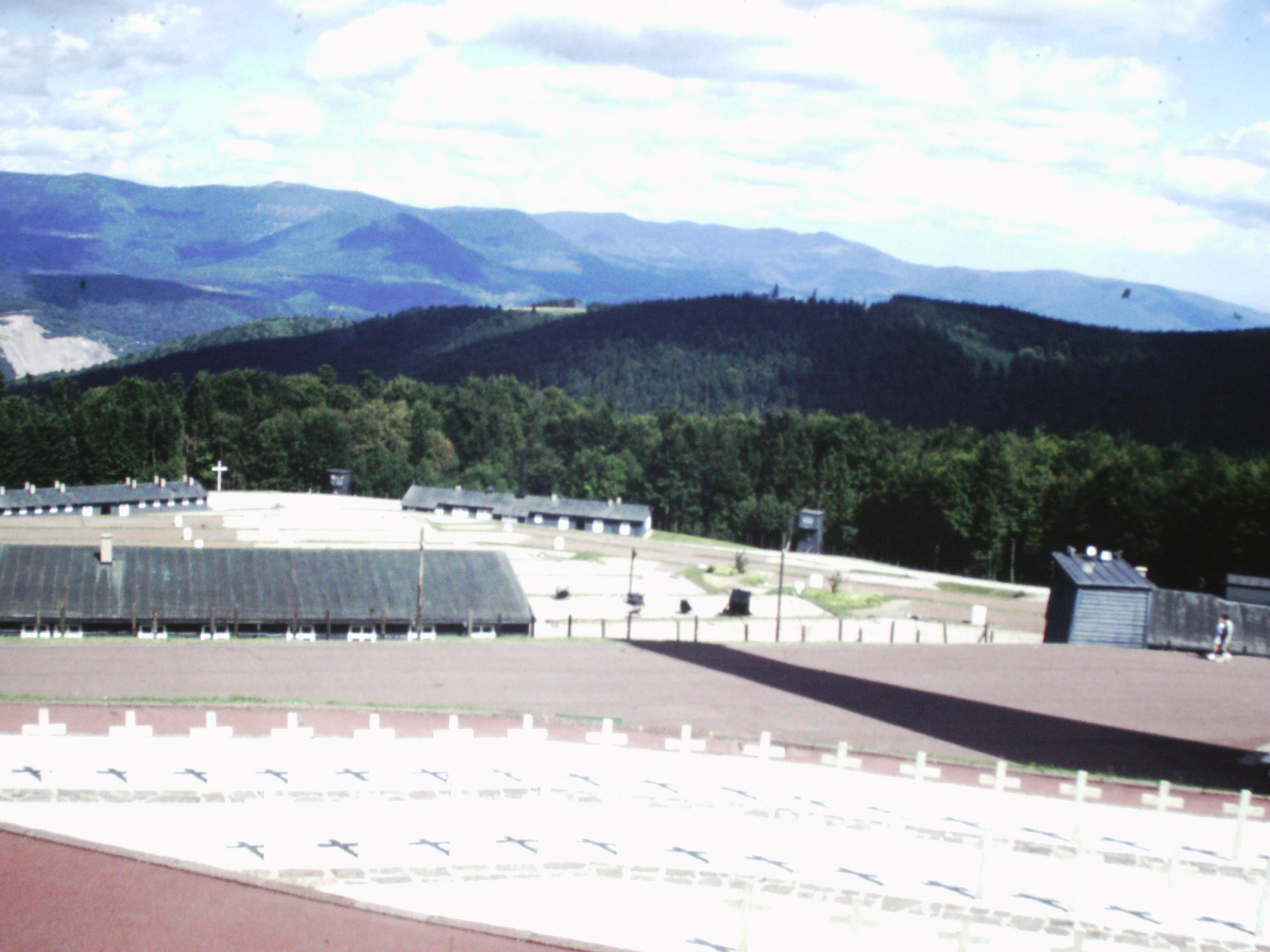The room I’m shown to is spotlessly clean, which is a problem because I, to put it mildly, am not: I am hiking across Europe, from the North Sea to the Mediterranean, and on this hot and humid summer day, I look like a vagabond and stink like a stevedore. The red-and-white blazes of the hiking route have brought me to the door of the Chateau d’Alteville, which was a gift to the owner’s great-great (times a few) grandfather, given in return for services in Napoleon’s army. During the Second World War, the chateau’s history again intersected with world history: Its owners were deported to the Pyrenees, and the chateau was expropriated, used, and looted by the Nazis. Some scars remain.
The owner politely ignores my trail-dusted condition, leaving me to wonder how I can even remove my filthy clothes without getting dirt all over everything. Somehow, I manage to extricate myself from my clothes without dropping them on anything white, then put on my travel dress, and make my way to dinner, where a half dozen other guests are involved in a multi-lingual conversation in French, German, English, and Spanish.
In Your Bucket Because…
- Hiking takes you to small villages you would never otherwise even know about.
- It’s a great way to meet locals.
- You will burn off all the delicious French food you eat.
- Good for: Outdoors lovers in fairly good shape.
The Many Faces of Euro-Sytle Hiking
Staying in a historic chateau is only one face of hiking Euro-style. Others include staying at farmhouses, in communal lodgings maintained for foot and bike travelers (called gîtes d’étap), at high altitude alpine refuges that offer family-style meals complete with wine; and in inns, hotels, private homes, and public campgrounds.
Grande Randonée means “Great Hike” in French, an apt description for a trail that traverses Holland, Belgium, Luxembourg, and France, with short detours into Switzerland and Italy. The route passes Dutch dikes, Flemish battlefields, Alsatian wine country, and the highest Alpine peaks in western Europe. The majority of its mileage is in eastern France. Parts of the route are easily accessible from several medium-sized European cities (see “Practicalities” below), making for easy day-hike outings. For multi-day trips, many sections have lodgings conveniently spaced so you don’t have to carry camping equipment.
The Low Countries: Hiking the GR-5 in the Netherlands, Belgium, and Luxembourg
The Netherlands: The busy harbors near Rotterdam seem an inauspicious place to start a hiking trail, but that’s where the northern terminus of the GR-5 is located, and, finding a place that gives access to the sea, we scramble down to dip our toes into the water to mark the beginning of our trek. The Dutch section of the trail is, in a word, flat. It also runs through settled suburbs and farmland, where the crooked cornstalks look exactly like those painted by Van Gogh. Much of the hiking is pleasant and easy across beaches and parkland; little of it is dramatic: All in all, this is a better choice for walkers more interested in culture and towns than wilderness experience. Although many urban Dutch people are fluent in English, rural residents are less likely to speak English, and a phrasebook comes in handy.
Belgium is divided into Flanders, which is the Dutch (or Flemish) speaking side, and Wallonie, the French-speaking side. Many Belgians speak English as a second language. The terrain in Flanders is hillier than in the Netherlands, and has a more rural feel. What I feel most keenly here is the presence of World War history — both I and II. Passing through battlefields, I find myself peering into the inside of bunkers still standing in the woods, wondering what it would have been like to stand in those tiny little structures for hours on end, waiting for the enemy to come. Every village has a war memorial listing the names of the dead, and scores of tiny museums preserve their memories, some containing little more than a few helmets and broken tanks — but all of them containing stories. The route becomes even more rural in Wallonie, where the hills get bigger, and more of the trail winds through forests and fields. And yes, in Flanders fields, the poppies blow.
Luxembourg is a compressed country with an astonishing variety of landscapes, including yet more World War II battle sites, medieval castles, sunny vineyards, and bucolic farms. There is a section of limestone cliffs and ravines that have earned the name Little Switzerland (although you certainly won’t see any towering Alps). The trail here is are well-maintained and marked. In the towns along the trail, I found myself constantly waylaid by yet another little museum, not to mention a cuisine that combines French style with German heft.
Hiking the GR-5 in France, Switzerland, and Italy
France: The trail enters France in Lorraine — another section of the trail that isn’t prime hiking in the traditional sense. The trail is inconsistently marked, and alternates between forests and heavily settled areas with a gritty working-class feel. This was, after all, the heavily industrialized region of France coveted by Hitler, and the trail actually passes the fortifications of the historic Maginot Line. Interestingly, despite its being one of the least dramatic hiking sections, Lorraine gave me some of my favorite memories. The Napoleonic chateau where I fretted about my dirt was in Lorraine, as was a small private home where the proprietor took in hikers and told us about being a little girl when the American GIs arrived: Most of all, she remembered the chocolates. In one down-at-the-heels town, one hotelier looked absolutely shocked to find out that someone actually wanted to stay in his inn, but he quickly rallied: Chef Louis cleaned a room for us, put on his best toque, prepared a fine steak-frites, and looked proud and happy when we selected the “good strong cheese” and red wine for desert. Old men on the street, on learning we were Americans, broke into wide, toothless grins and insisted on sharing their memories as if we were the only Americans they’d seen since those GIs in World War II. Lorraine was the section of trail that proved that hiking can be about much more than pretty views and getting from one place to another.
Alsace. Next door, Alsace is more attractive to tourists with its riverside vineyards, pretty villages, and the Vosges Mountains, which would be taken more seriously if only they weren’t so close to the Alps. This region has a long history of merged France-Germanic culture; a side visit to Strasbourg is a must, as is a much more sobering visit to the Struthof Nazi concentration camp, which is right along the trail.
The Swiss-French Borderlands: After traversing the Vosges, the trail follows the the Swiss-French border near Lake Geneva. We crossed the lake by ferry (no, thru-hiking does not require you to swim!) and ascended into Switzerland for a few days. The trail then returns to France and skirts Mt. Blanc, the highest peak in western Europe. In the high Alps, hikers enjoy generally mild weather (although it can snow, even in summer) and a system of high country refuges that provide lodging and family-style meals.
The French-Italian Borderlands:l Walking south along the Italian border into the drier, starker Maritime Alps brought us to a landscape that combined Alpine drama with Mediterranean vegetation. The crowds are thinner here than in the High Alps to the north.
The trail ends on the beach at Nice (or a bit farther east, if you take the alternate route through Mercantour National Park). Loaded down with backpacks and hiking boots, we walked past the topless bathers, feeling every bit as out of place as we had in that chateau back in Lorraine. But here as there, no one seemed to mind, nor paid us any attention, and we dipped our toes in the water to mark the end of our trip.
Practicalities
- The GR-5 can be hiked in its entirety over about 4 months, or can be broken into shorter journeys.
- For day hikes, you can pick up local topoguides in any outfitting store. These contain trail descriptions (in French) and 1:50,000 maps, sufficient to follow the trail, which is marked in red and white blazes.
- For dayhikers, the trail is conveniently close to Rotterdam and Maastricht (Holland), Liège (Belgium), Luxembourg Ville (Luxembourg), Strasbourg, Nancy, and Metz, (northeastern France), Lausanne and Montreux (Switzerland), Briançon in (France; at 1326 meters, Briançon is the highest city in the European Union), and Nice, where the trail ends at the beach. It also passes near Chamonix.
- The GR-5 is well-blazed for most of its entire length, and described and mapped in a series of topoguides, some of which are available in English.
- Lodgings are readily available. It is possible to hike the entire trail without carrying camping equipment if you can manage a few 20 + mile days. For the most part, lodgings are 10 to 15 miles apart, especially in the Alps. Reservations are recommended for alpine huts in the high season.
- Bring proper hiking clothes for the Alps: It snowed on us.
- If you speak French, you can find more information at The French Hiking Federation (or struggle through the ridiculous computer translation to English).



